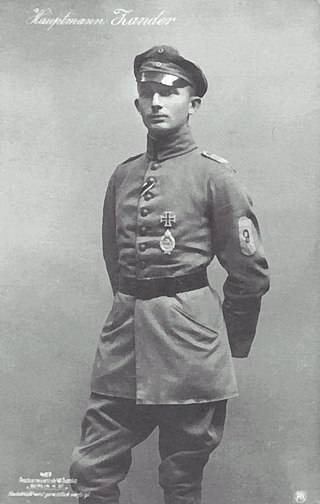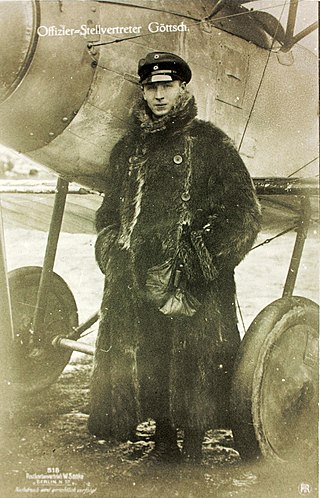
OberleutnantFritz Otto Bernert was a leading German fighter ace of World War I. After being invalided from infantry duty after his fourth wound, Bernert joined the aviation branch. After pilot training, he scored 27 victories between 17 April 1916 and 7 May 1917 despite being essentially one-armed and wearing pince-nez. Among his 15 victories during Bloody April were five scored in 20 minutes on 13 April 1917. He was promoted to squadron command, first of Jagdstaffel 6, then of Jagdstaffel 2. Removed from command on 18 August 1918 by wounds and illness, he died of influenza on 18 October 1918.
Leutnant Hermann Becker, was a World War I German flying ace credited with 23 victories.
Hans Klein was a German World War I fighter ace credited with 22 aerial victories.
Leutnant Hans-Georg August von der Osten began his career as a World War I flying ace credited with five aerial victories. He later rose to command of all Luftwaffe bases in Germany, during World War II.
Leutnant Werner Wagener was a World War I flying ace credited with five aerial victories. As a Fokker Eindekker pilot, he was one of the first flying aces in history.

HauptmannMartin Zander was a World War I flying ace credited with five aerial victories. He was appointed to command one of the original German fighter squadrons, Jagdstaffel 1, before becoming an instructor.
OberleutnantErich Hahn was a World War I flying ace credited with six aerial victories.
Leutnant Friedrich von Mallinckrodt was a German World War I test pilot and flying ace credited with six aerial victories.
Leutnant Fritz Gerhard Anders was a World War I flying ace credited with seven aerial victories. He was the world's first night fighter ace.
Leutnant Ernst Hess HOH IC was a World War I flying ace credited with 17 confirmed and four unconfirmed aerial victories. Hess was one of a few World War I pilots involved in aviation prewar, as he gained his civil pilot's license on 26 September 1913. He was already enrolled in Die Fliegertruppen of the Imperial German Army when World War I began. He qualified for his military pilot's license on 21 November 1914, and was launched on his flying career as one of Germany's first fighter pilots. He would score his first aerial victory in tandem with Oswald Boelcke on 5 January 1916. He would rotate through four assignments before scoring a dozen victories within July–September 1917 while flying an Albatros D.Va for Jagdstaffel 28. On 19 September 1917, he was promoted to command of Jagdstaffel 19. He had just been appointed to command of a Jagdgruppe being formed by Germany's First Army when he was killed in combat on 23 December 1917.
LeutnantRudolf Klimke IC was a German World War flying ace credited with 17 confirmed and two unconfirmed aerial victories. Serving initially as a bomber pilot, his aggressiveness in bombing England, and in shooting down a couple of enemy airplanes got him reassigned to a fighter squadron. After a string of a dozen victories during 1918, he was wounded in action on 21 September 1918.
Leutnant Johannes Klein was a German World War I flying ace credited with 16 confirmed and two unconfirmed aerial victories. He should not be confused with another Johannes Klein, who was actually the driver for and present during the assassination of Reinhard Heydrich.
Ernst Freiherr von Althaus was a German flying ace in World War I, credited with nine confirmed aerial victories, as well as eight unconfirmed ones. He was one of the original Fokker Eindekker pilots who became known collectively as the Fokker Scourge.

Leutnant Walter Göttsch HoH, IC was a German World War I flying ace credited with 20 aerial victories. His final combat assignment was commanding Jagdstaffel 19 in Jagdgeschwader II.
Leutnant Heinrich Arntzen was a German World War I flying ace credited with eleven aerial victories.

Lieutenant Rudolf Stark was a World War I flying ace credited with eleven confirmed and five unconfirmed aerial victories.
OffizierstellvertreterBernhard Ultsch was a World War I flying ace credited with twelve aerial victories.
Leutnant Rudolf Matthaei was a German World War I flying ace credited with ten aerial victories.
Leutnant Arno Benzler was a German First World War flying ace and aerial commander credited with nine confirmed aerial victories.
Leutnant Hans Karl Müller was a pioneering German flying ace during World War I. He was credited with nine aerial victories. He also taught many others to fly, as an instructor in the German Air Service, and later, as a civilian instructor in Mexico.






